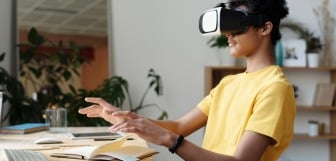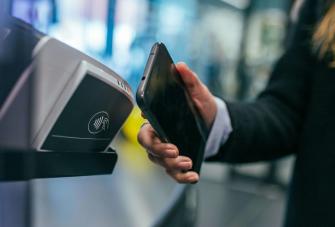VR and AR in Retail
Now that we have officially entered the 2020s, it could be safely said that we’ve reached a point where technology is inseparable from our lives. Advances in technology and changes to customer habits have reshaped the retail industry into something we could only dream of a decade or two ago.
One of the most exciting aspects of these advances is the blossoming world of augmented reality (AR) and virtual reality (VR). While neither of these technologies has reached the heights of the fictional holo-deck in Star Trek: The Next Generation, they are already proving themselves to be exciting tools in the retail space.
In this blog, we’re going to be exploring VR and AR in retail and see how they’ve both been used in the physical world for marketing purposes or retail businesses. While not every business will have access to this incredible technology at the moment, there may be a time in the future when half your sales come in thanks to this technology.
What is VR and AR?
You may be asking yourself at this point, “what exactly is VR and AR?” Don’t worry if you don’t know the answer as both have only become widely available in the last couple of years. Although they sound very similar, AR and VR are two distinct pieces of technology and we’re going to define both of them for you.
AR
The clue to understanding AR is the name. AR, or augmented reality, uses a compatible device, usually a smartphone or tablet, to augment reality with the device’s camera. This is done by overlaying digital elements onto the real world. These overlays can also include music, sounds, graphics, and text.
A good example of AR would be the facial filters on the popular apps Instagram and Snapchat. While it may not be as immersive as VR, AR can still inspire real-world action. For instance, Pokemon Go, one of the most popular mobile games of the last decade, is entirely based on AR technology.
The main benefit of AR over VR is that it is incredibly user friendly and simple to use. Unlike VR, which often require extra equipment, all AR experiences need is a smartphone or compatible device with a camera. This means that a unique customer experience can be quickly incepted and pushed out to the public. With the right assistance from an AR company, everyone from an established business to pop up shops can take advantage of this technology.
VR
VR is currently the be-all-end-all when it comes to immersive experiences. VR is much more immersive than AR and uses specialist equipment such as VR headsets to create entire virtual worlds. Users are almost fully insulated from the outside world with headphones and headsets and use motion controls to move around in virtual space.
Until recently, the technology was used as a gimmicky way to provide VR experiences at events and theme parks. As technology has improved, however, the retail world is waking up to the possibilities offered by VR.
Imagine you’re a fashion fan but are nervous about buying expensive pieces of clothing without seeing how they look on a person. VR has the ability to put you in the front row at the most exclusive show of Paris Fashion Week. This allows you to see the clothes on the runway, fully realised in front of you.
While VR does require specialised equipment, it offers an experience that otherwise couldn’t be replicated. In a retail context, VR allows the consumer to get first-hand experience of a product before they commit to a purchase.
Examples of VR and AR in retail
Now that we understand what AR and VR both are and how they can be used to promote retail sales, it’s a good time to list some real-world examples of how these experiences have worked in the past. This may even give you some ideas for how you could use these technologies in your own business
ASOS
The use of VR and AR in fashion retail has become very popular. ASOS has now given its customers the chance to see certain pieces of clothing on 3D models before they commit to a purchase. This “try before you buy” system gives customers more confidence in their spending habits and leads to more sales.
IKEA
There’s nothing worse than getting home from IKEA and realising your new wardrobe doesn’t fit in your bedroom. IKEA has solved this issue by allowing their customers to use their phone app to see how the piece of furniture would fit in their room. This visualisation keeps customers happy and gives them a lot more trust in their purchase.
Nike
Nike is one of the leading companies currently offering VR and AR experiences to their customers. Their use of AR allows their customers to see what their shoes will look like and scan them for more information. In their flagship stores, customers can enter a VR presentation that follows certain pieces of clothing on their journey from creation to store shelf.
Toms
The popular shoe company Toms has always pledged to donate $1 of every $3 they make to local people that play roles in their supply chain in South America. In hundreds of their stores, Toms offers a VR experience that takes their customers to Peru so they can see first-hand where their money is going and how they’re helping the community. Customers are sure to spend that little extra once they see the impact they’re making.
Apple
Of course, one of the biggest technology companies in the world would embrace AR marketing. During the COVID 19 pandemic, Apple allowed their customers to use AR quick looks to see how their iMac and laptop products would fit in their homes. As one of Apple’s main concerns is the aesthetic of their products, this was a great way to bring their sleek design into the homes of their customers.
VR and AR both offer exciting opportunities for businesses looking to make a unique impact on the retail market and attract customers. This technology is only set to improve and its influence widens until it becomes an accepted part of our lives.
The best EPOS system for retail
When building a business, you’ll need strong foundations to support your growth. Electronic point of sale (EPOS) systems work as the backbone of retail businesses for a number of reasons. Designed to work as a complete business management system, you can control all vital aspects of your company from one cloud-based system.
Receive detailed analysis on the areas that matter to your business:
- Filter sales reports by individual product, profit margin, trending items, or employee
- Multi-award-winning inventory management that syncs online sales and in-person sales for the most up-to-date stock levels
- Build your own website or integrate with a fully loaded ecommerce platform
- Automatic order purchasing once stock once it falls below a certain level
- Customer management systems that save customer contact details and shopping preferences for more targeted marketing
- Integrations with over 100 apps including marketing, accounting, bookkeeping, and loyalty program apps
- Employee management for more efficient scheduling and payroll
If you’d like to learn more about our industry-leading software, contact us today.



